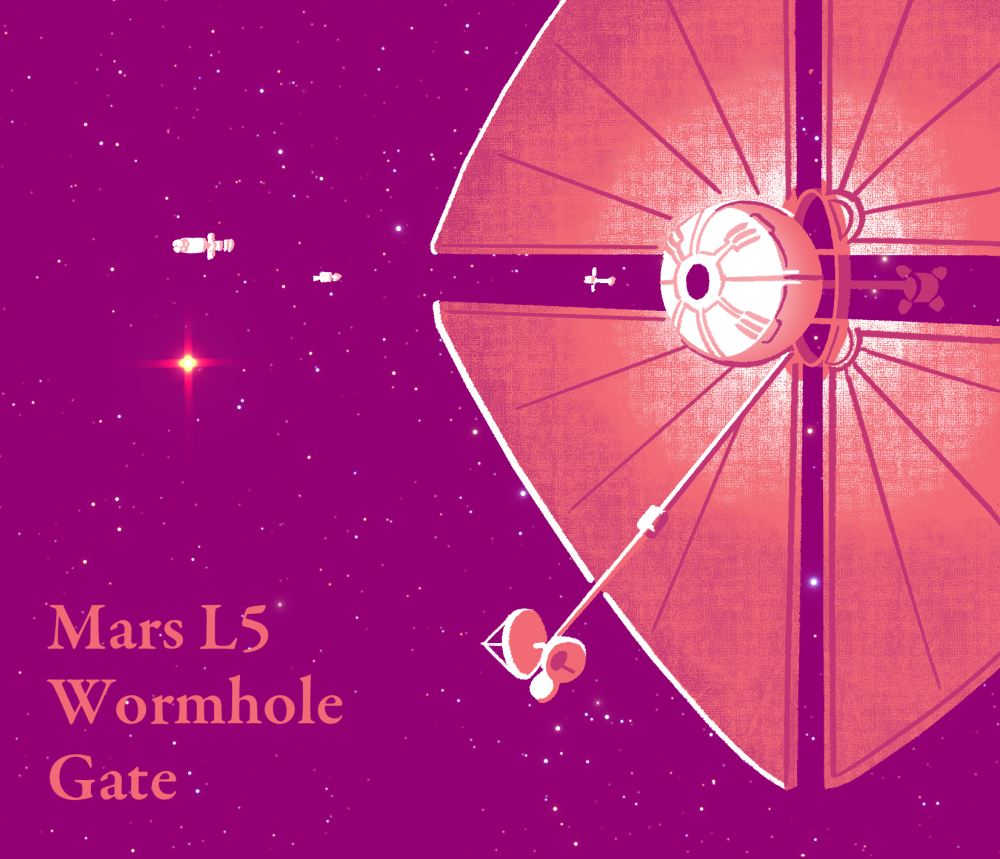 Artificial wormholes are the primary method of interstellar transit, as all ship propulsion drives operate below lightspeed. They are a temporary pinch in spacetime, connecting two points that otherwise are thousands of years of slower than light travel apart. Wormhole gates are huge structures with massive power requirements, and a failure risk of violent implosion. As such, there are rarely more than a 3 in a given system, and near inhabited worlds they are placed no closer than the L1 and L2 Langrange points to avoid radioactive and shrapnel fallout in case of disaster. Wormhole gates originate from bug ferret technology and the vast majority of hub gates in the network are under BFGC control, a common point of contention in galactic politics.
Artificial wormholes are the primary method of interstellar transit, as all ship propulsion drives operate below lightspeed. They are a temporary pinch in spacetime, connecting two points that otherwise are thousands of years of slower than light travel apart. Wormhole gates are huge structures with massive power requirements, and a failure risk of violent implosion. As such, there are rarely more than a 3 in a given system, and near inhabited worlds they are placed no closer than the L1 and L2 Langrange points to avoid radioactive and shrapnel fallout in case of disaster. Wormhole gates originate from bug ferret technology and the vast majority of hub gates in the network are under BFGC control, a common point of contention in galactic politics.
Wormholes can be generated in two different ways: a "thrown" wormhole is created by a gate machine on one end, with the other end opening into approximate coordinates of space. These are used to create new gates, as builder drone vehicles are sent through the thrown hole to construct a new wormhole gate at the other end. The end location of these thrown wormholes isn't terribly precise, and it can take several attempts to pinpoint the desired end point. A "linked" wormhole connects two gate machines, allowing objects and laser communication to pass between the two seamlessly. These are far more stable and reliable for transportation.
A given gate machine will have a fixed range within they can connect to other gates, tied to their maximum power consumption. Wormhole transport networks often consist of local gates, which have smaller power requirements and short range, and hub gates, which have longer range and high power requirements. Hub gates are most often located in close orbit of uninhabited stars, using thousands of kilometers of solar panels to power their operation.
The vast majority of a journey between planets through these networks is spent on getting to and from the gates, while gate transportation is more or less instantaneous aside from waiting in the queue to enter the gate. Gate houses will often group ships into batches to a specific location before linking there, to save on the power requirements of holding open a wormhole.
Interstellar communication standards use a combination of laser beams to transmit to wormholes, and wormhole switchboards to send laser-encoded information to other parts of the galaxy. These switchboard open and close dozens of microscopic wormholes to send light beams through, delicately balancing power draw and spacetime bending. Wormhole switchboards are most often connected to larger transport gates due to their intense power draw and similar collapse risks, though some low-population colonies risk having them in high orbit for the speed benefits.
A skyhook is an active tether transport satellite positioned in low orbit. The entire structure rotates, and the end of tether has a hook (attachment point) for boats (spaceplanes) and/or a variety of other payloads. Incoming payloads are grabbed by the skyhook and slowed down for easier landing, and in the process lend some of their kinetic energy to the skyhook's swing. Outgoing payloads attach to the skyhook and are "flung" into higher orbit, which boosts their speed and removes some kinetic energy from the skyhook. Incoming and outgoing payloads can passively balance the spin speed of a skyhook and offset some of the energy cost for escaping the gravity well of a large planetary body.
Skyhooks operating around a body with a thick atmosphere tend to perform less efficiently, as their orbit is low enough for air drag to slow their spin and gradually degrade their tether material.
The skyhook in orbit of Dirtball works in concert with a launch loop to transfer payloads directly from a maglev rail to the hook. The diagram below shows a simplified version of this process, though in real time the spin of the skyhook is much slower, with the hook only passing close to the planetary surface at three points in its entire orbit.

A launch loop is an ultra-lightweight active support rail structure that extends above the surface of a body, lifted off the ground by 2 or more rotor belts circulating through its entire length and held down into the desired height and shape by long cables. They can vary greatly in size and shape depending on the gravity and atmosphere of their location. On planets around 1g with a dense atmosphere, they are typically over 80 kilometers tall and may be up to 3000 kilometers long. On small moons with little to no atmosphere, they may only be a few kilometers tall and 100 kilometers long. They represent a major infrastructural investment but can greatly offset the costs of moving heavyweight payloads out of a body's gravity well.
Payloads are loaded onto rails at one of the teardrop shaped ends of the launch loop, climb the ascent to the maximum elevation of the loop, are accelerated to their escape speed by the maglev rail, and then finally release from the rail.